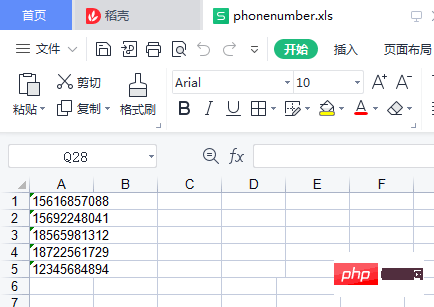Python 파일 데이터 분석, 관리 및 추출에 대해 이야기해 보겠습니다.
- WBOYWBOYWBOYWBOYWBOYWBOYWBOYWBOYWBOYWBOYWBOYWBOYWB앞으로
- 2022-08-25 11:46:461855검색
【관련 추천: Python3 동영상 튜토리얼】
전제 조건 요약
Python2.0은 중국어 경로를 직접 읽을 수 없다는 문제점이 있으며, 추가 기능을 작성해야 합니다. 2018년에는 python3.0을 직접 읽을 수 없습니다.
지금 사용해 보니 python3.0이 중국어 경로를 직접 읽을 수 있다는 것을 알게 되었습니다.
여러 개의 txt 파일을 가져오거나 만들어야 합니다. 그 안에 몇 가지 데이터(이름, 휴대폰 번호, 주소)를 작성하는 것이 가장 좋습니다.
요구 사항
몇 가지 요구 사항을 직접 작성할 때 가장 좋습니다. 다음 목적을 명확히 하십시오.
- 해당 디렉터리 경로에서 해당 파일을 모두 읽어야 합니다
- 해당 txt 파일의 기록을 한 줄씩 읽습니다.
- 정규식을 사용하여 각 줄의 휴대폰 번호를 가져옵니다
- 휴대폰 번호를 엑셀에 저장
- 1) 파일 읽기
- 2) 데이터 읽기
- 3) 데이터 정렬
- 4) 정규식 일치
- 5) 데이터 중복 제거
- 6) 데이터 내보내기 및 save
import glob
import re
import xlwt
filearray=[]
data=[]
phone=[]
filelocation=glob.glob(r'课堂实训/*.txt')
print(filelocation)
for i in range(len(filelocation)):
file =open(filelocation[i])
file_data=file.readlines()
data.append(file_data)
print(data)
combine_data=sum(data,[])
print(combine_data)
for a in combine_data:
data1=re.search(r'[0-9]{11}',a)
phone.append(data1[0])
phone=list(set(phone))
print(phone)
print(len(phone))
#存到excel中
f=xlwt.Workbook('encoding=utf-8')
sheet1=f.add_sheet('sheet1',cell_overwrite_ok=True)
for i in range(len(phone)):
sheet1.write(i,0,phone[i])
f.save('phonenumber.xls')
실행 결과



import glob
import re
import xlwt
globe는 파일을 찾는 데 사용되며 정규식은 xlwt는 Excel에 사용됩니다. 1) 파일 읽기 filelocation=glob.glob(r'课堂实训/*.txt')
지정된 디렉터리의 모든 txt 파일2) 데이터 읽기for i in range(len(filelocation)):
file =open(filelocation[i])
file_data=file.readlines()
data.append(file_data)
print(data)
경로 아래의 txt 파일을 반복하면서 일련번호별로 파일을 순차적으로 읽습니다해당 파일을 엽니다.
주기마다 txt를 읽어옵니다. 파일 데이터는 한 줄씩 읽혀집니다.
append() 메소드를 사용하여 각 행의 데이터를 데이터 목록에 추가합니다
출력하면 여러 개의 txt 파일 데이터가 저장되어 있는 것을 볼 수 있습니다. 문자 열 형식으로 동일한 목록에
combine_data=sum(data,[])
목록이 하나의 목록으로 병합됨4) 정규식 일치 및 데이터 중복 제거print(combine_data)
for a in combine_data:
data1=re.search(r'[0-9]{11}',a)
phone.append(data1[0])
phone=list(set(phone))
print(phone)
print(len(phone))
set() 함수: 순서 없는 중복 제거, 순서 없는 중복 생성 반복되지 않는 요소 집합
6) 데이터 내보내기 및 저장#存到excel中
f=xlwt.Workbook('encoding=utf-8')
sheet1=f.add_sheet('sheet1',cell_overwrite_ok=True)
for i in range(len(phone)):
sheet1.write(i,0,phone[i])
f.save('phonenumber.xls')
- Workbook('encoding=utf-8'): 통합 문서의 인코딩 설정
- add_sheet('sheet1', cell_overwrite_ok=True) : 해당 워크시트 만들기
- write(x ,y,z): 매개변수는 행, 열 및 값에 해당합니다
Python3 비디오 튜토리얼]
위 내용은 Python 파일 데이터 분석, 관리 및 추출에 대해 이야기해 보겠습니다.의 상세 내용입니다. 자세한 내용은 PHP 중국어 웹사이트의 기타 관련 기사를 참조하세요!
성명:
이 기사는 jb51.net에서 복제됩니다. 침해가 있는 경우 admin@php.cn으로 문의하시기 바랍니다. 삭제


